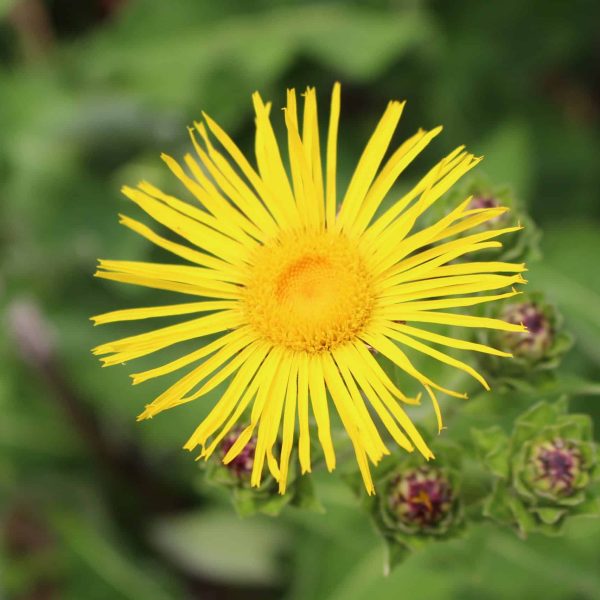-
How does it feel?
Vacha is a semi-aquatic plant that grows in damp, marshy locations across the globe, but is native to India. It has long, slender and sword-shaped leaves with creeping rhizomes. The flowers are very small and fragrant and a pale-green in colour and fruits are small and fleshy. It is the rhizomes of the plant that are most important medicinally.
-
What can I use it for?
The essential oils within vacha are particularly penetrating for the mind, helping to clear the mind and provide relief from mental stagnation.
An essential oil present in the plant, Beta-asarone, demonstrates relaxant and anti-spasmodic activities within the digestive, respiratory and the urinary system. Components within the rhizome have also demonstrated pain-killing and anti-inflammatory activities within the same three body systems.
-
Into the heart of sweet flag
 The pungent and aromatic essential oils in vacha have made it an excellent herb for the removal of heavy, damp and congested toxicity throughout the body. It is considered to be a stimulant to the nervous system and an aromatic carminative to the digestive system. The activity of the essential oils appears to concentrate within the cerebral hemispheres and the mind, helping to shift emotional congestion that may be influencing stagnant depression and reduced cognitive abilities. This particular quality has made vacha a helpful herb for supporting recovery from stroke, epileptic attacks and loss of speech.
The pungent and aromatic essential oils in vacha have made it an excellent herb for the removal of heavy, damp and congested toxicity throughout the body. It is considered to be a stimulant to the nervous system and an aromatic carminative to the digestive system. The activity of the essential oils appears to concentrate within the cerebral hemispheres and the mind, helping to shift emotional congestion that may be influencing stagnant depression and reduced cognitive abilities. This particular quality has made vacha a helpful herb for supporting recovery from stroke, epileptic attacks and loss of speech.The primary application of vacha is to open the mind, improve concentration, clarity and speech. Its stimulating effect makes it useful in treating depression and mental sluggishness. It actually scrapes stagnation from the subtle channels of the mind. This acrid root is also used in childhood developmental problems and in post stroke speech difficulties. It specifically strengthens the ability of the mind to receive information and recall from memory.
The aromatic heating effect of vacha helps to calm the gastric nerves, prevent fermentation and clear excess congestion in dyspepsia, flatulence and borborygmus.
Vacha clears damp, wet coughs from the lungs. It also has an affinity for the throat and clears ‘obstructions’ from the throat. Its purgative effect on the head make it an excellent remedy for sinus congestion, nasal polyps and rhinitis.
The decongestant and pungent qualities of vacha have traditionally indicated its use in treating urinary gravel and infections.
-
Traditional actions
Herbal actions describe therapeutic changes that occur in the body in response to taking a herb. These actions are used to express how a herb physiologically influences cells, tissues, organs or systems. Clinical observations are traditionally what have defined these actions: an increase in urine output, diuretic; improved wound healing, vulnerary; or a reduction in fever, antipyretic. These descriptors too have become a means to group herbs by their effects on the body — herbs with a nervine action have become the nervines, herbs with a bitter action are the bitters. Recognising herbs as members of these groups provides a preliminary familiarity with their mechanisms from which to then develop an understanding of their affinities and nuance and discern their clinical significance.
-
Traditional energetic actions
Herbal energetics are the descriptions Herbalists have given to plants, mushrooms, lichens, foods, and some minerals based on the direct experience of how they taste, feel, and work in the body. All traditional health systems use these principles to explain how the environment we live in and absorb, impacts our health. Find out more about traditional energetic actions in our article “An introduction to herbal energetics“.
Chinese energetics
Western energetics
-
Did you know?
In India, vacha powder was traditionally mixed with ghee and given to newborn babies on the seventh day to improve speech and help develop the intellect.
Additional information
-
Safety
No drug-herb interactions are known. Always combine it with other aromatic herbs to offset the emetic nature; e.g. fennel, cardamom and peppermint. It is banned in the USA by the FDA because it contains β-asarone which is considered to be carcinogenic. β-asarone is not present in all varieties.
-
Dosage
1–5g/day dried root or 1–5ml/day of a 1:5 in 60% tincture.






























 The pungent and aromatic essential oils in vacha have made it an excellent herb for the removal of heavy, damp and congested toxicity throughout the body. It is considered to be a stimulant to the nervous system and an aromatic carminative to the digestive system. The activity of the essential oils appears to concentrate within the cerebral hemispheres and the mind, helping to shift emotional congestion that may be influencing stagnant depression and reduced cognitive abilities. This particular quality has made vacha a helpful herb for supporting recovery from stroke, epileptic attacks and loss of speech.
The pungent and aromatic essential oils in vacha have made it an excellent herb for the removal of heavy, damp and congested toxicity throughout the body. It is considered to be a stimulant to the nervous system and an aromatic carminative to the digestive system. The activity of the essential oils appears to concentrate within the cerebral hemispheres and the mind, helping to shift emotional congestion that may be influencing stagnant depression and reduced cognitive abilities. This particular quality has made vacha a helpful herb for supporting recovery from stroke, epileptic attacks and loss of speech.





